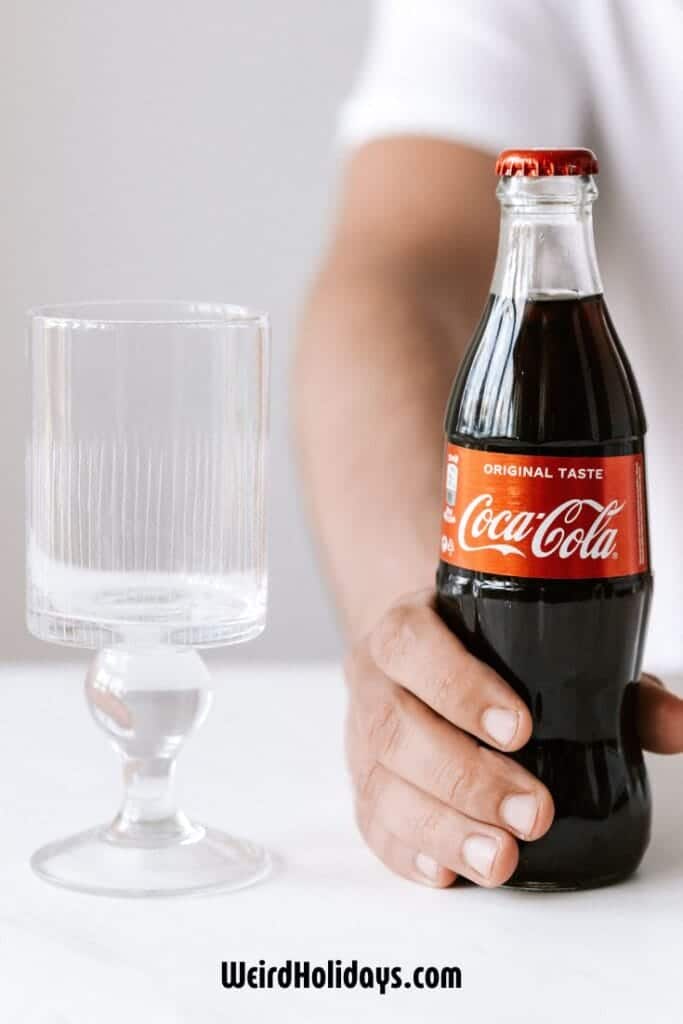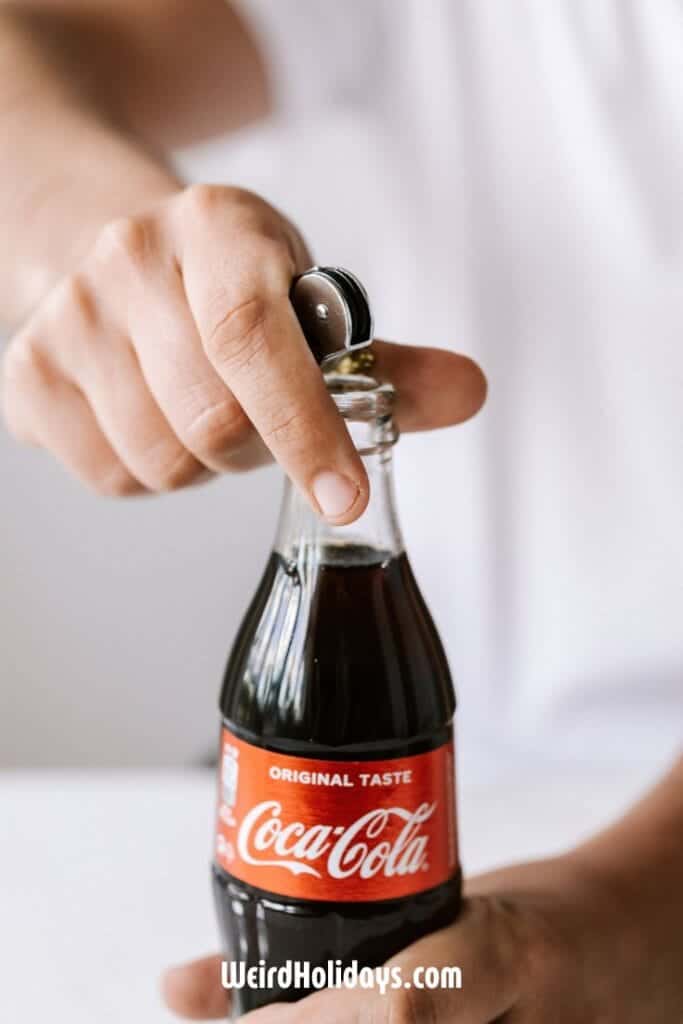National Have a Coke Day (May 8)

National Have a Coke Day is a fizzy celebration of one of the most iconic beverages in the world.
Whether it’s sipped from a vintage glass bottle or poured over ice, Coca-Cola is a symbol of nostalgia, joy, and refreshment.
May 8 is the perfect excuse to take a break, crack open a Coke, and enjoy a taste that’s been a part of pop culture for over a century. It also happens to be one of the weird holidays in May.

When Is the Holiday?
National Have a Coke Day is observed each year on May 8.
Who Invented It?
The exact origin is unclear. It likely began as a promotional event by fans or marketers celebrating Coca-Cola’s cultural impact.
Like many unofficial “national” days, it may have gained traction through social media and grassroots enthusiasm.

The History of the Holiday
The roots of this celebration go back to 1886, when pharmacist John S. Pemberton created Coca-Cola in Atlanta, Georgia. Initially sold as a tonic, it quickly became a popular fountain drink.
Over time, Coca-Cola evolved from a local refreshment into a global brand, shaping advertising, pop culture, and even wartime morale.
The holiday reflects both its historic legacy and continued relevance.

Top 5 Facts About the Holiday
- Coca-Cola was first sold for 5 cents a glass.
- The original formula contained cocaine, removed by 1929.
- The famous contour bottle design dates back to 1915.
- Coca-Cola funded over 60 bottling plants for U.S. troops during WWII.
- The brand is recognized in over 200 countries worldwide.

Activities to Celebrate
Sip your favorite Coke. Whether it’s a glass bottle of Classic Coke, a can of Diet, or a unique flavor like Cherry Vanilla or Orange Vanilla, take a moment to enjoy the taste that started it all.
Host a Coke-themed taste test party. Gather a few friends, grab multiple Coke varieties (classic, zero sugar, cherry, etc.), and do a blind taste test. Add themed snacks and vote on favorites—great for family fun or a quirky get-together.
Visit the World of Coca-Cola museum. If you’re near Atlanta, Georgia, spend the day exploring interactive exhibits, sampling Coke products from around the world, and seeing the vault where the secret formula is kept.
Try a Coca-Cola craft or coloring sheet for kids. Create Coke bottle collages, design your own soda labels, or use our printable vintage Coke ad posters as coloring pages for a retro art activity.
Share your Coke story or collectible online. Whether it’s your first sip of Coke from a glass bottle or your favorite branded lunchbox, post your memories or collectibles with #HaveACokeDay.
Watch vintage Coca-Cola ads on YouTube. Take a trip down memory lane with classic commercials—from the “Hilltop” ad to the Coca-Cola polar bears. Great for sparking nostalgia and conversation.

Related Recipes for the Holiday
Original Coca-Cola Cake Recipe. A Southern classic with rich chocolate cake and a silky Coke-infused frosting. Moist, dense, and perfect for celebrations.
Coca Cola Slushie. Cool down with this frosty drink made from Coke and crushed ice. Easy to whip up in minutes and incredibly refreshing.
Pulled Chicken Sliders with Coke. Crockpot sliders with sweet and tangy flavor, topped with crisp apple cabbage slaw—great for potlucks or weeknight dinners.
Cherry Coke Smoked Pork Shoulder. Infused with Cherry Coke and slow-smoked for hours, this pork shoulder is juicy, flavorful, and perfect for BBQ lovers.
Cherry Coke Cupcakes. A fun twist on classic chocolate cupcakes, topped with maraschino cherries and whipped cream for a soda shop vibe.
Cola Marinated Steak. Tender and full of flavor, this steak marinates in cola before being reverse seared for that perfect bite.
Coca Cola Cake Mix Cookies. Only a few ingredients needed for these soft, chewy cookies with a hint of cola flavor.
Crock Pot Ham with Cola Glaze. A sweet and tangy glaze made with Coke and pineapple gives this ham a juicy, caramelized finish.
Slow Cooker Coca Cola Pot Roast. Hearty, tender, and full of savory flavor. This slow-cooked pot roast makes a cozy meal for National Have a Coke Day.

**This post may contain affiliate links. As an Amazon Associate and a participant in other affiliate programs, I earn a commission on qualifying purchases.**
Links to Resources
World of Coca-Cola – Plan your visit or take a virtual tour of Coke’s interactive museum experience in Atlanta.
Coca-Cola Company History – Explore a full timeline of Coca-Cola’s development, global reach, and innovations.
Coca Cola Slushy Maker – Officially licensed Coca-Cola product that makes floats, slushies, and shakes in 7 minutes. No bulky equipment, just freeze, mix, and enjoy.
Secret Formula: The Inside Story of How Coca-Cola Became the Best-Known Brand in the World – A fascinating behind-the-scenes look at Coca-Cola’s business, branding, and influence. This book dives deep into the history, legal battles, and secretive culture that built the world’s most recognized brand.

Related Holidays
Coca-Cola pairs perfectly with other quirky springtime celebrations:
- National Lemon Juice Day (August 29) – Perfect mixer for refreshing drinks.
- National Junk Food Day (July 21) – An ideal match for Coca-Cola. Burgers, chips, candy—whatever your favorite treat, a Coke makes it better.
- National Iced Tea Day (June 10) – Sweeten it with Coke for a Southern favorite.

Pin it!
Share this post about National Have a Coke Day on Pinterest!

